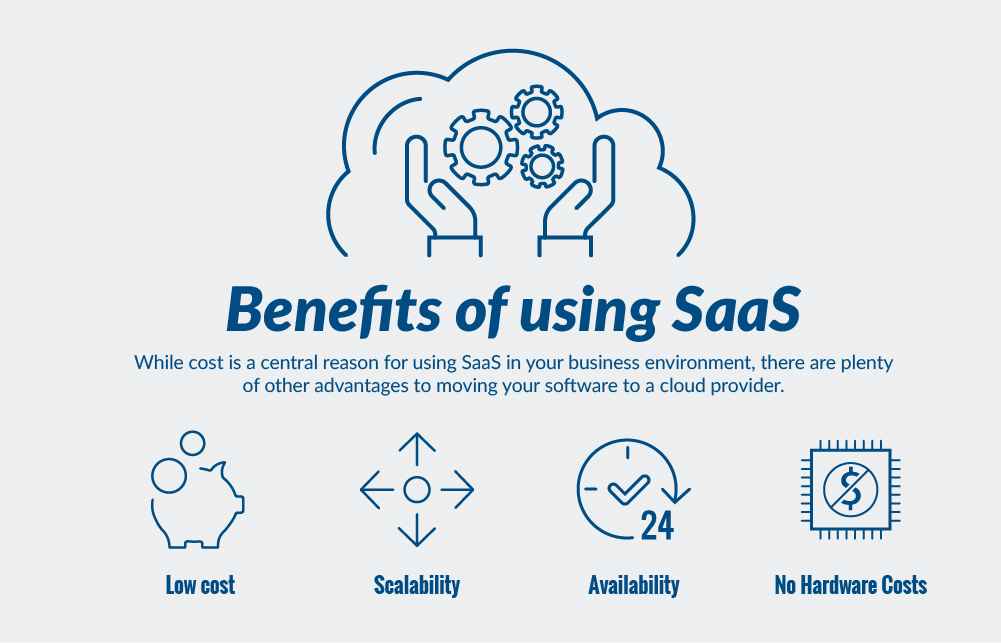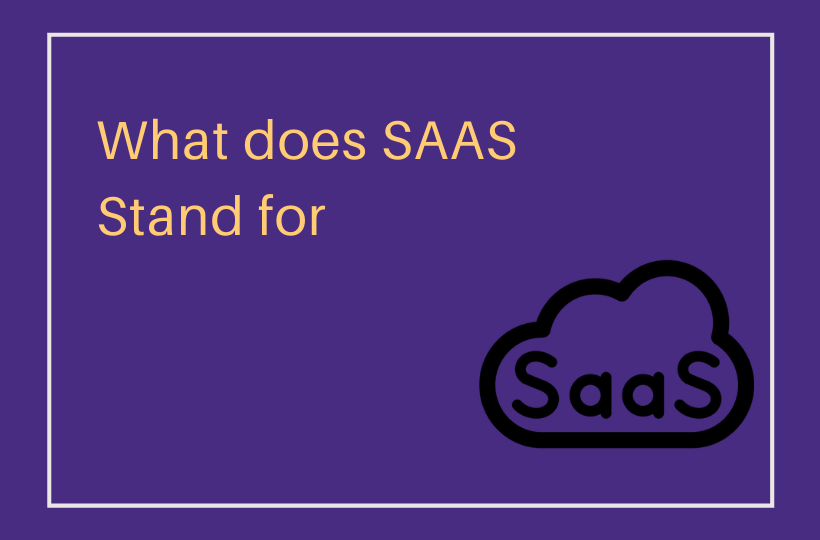The SAAS stand for Software as a Service a software distribution business deployment model. It delivers, manages, and distributes application programs and cloud-software services on a subscription basis. The main goal behind SAAS is to no need of downloading a bunch of programs on computers anymore. Throughout the lifecycle, the SAAS provider or distributor is responsible for maintaining the application service. Customers can simply access it through the internet connection therefore, it is also known as web-based software, on-demand software, or hosted software. Now, let’s take a brief look at what does SAAS stand for?

History of SAAS
The history of SAAS began with a speech by a well-known computer scientist John McCarthy. He gave the idea of cloud computing and also won the Turing award for his work in artificial intelligence (AI). In the late 1990s, many web-based technologies started supporting the cloud computing model called SAAS. Such as Salesforce had developed cloud software that offered traditional enterprise solutions, customer relationship management (CRM), etc.
Traits of SAAS
SAAS functions similarly to a bank that manages and protects the money & financial information of customers. Eventually, SAAS provides massive application services to customers in a reliable and secure way. The key traits of the SAAS model are as follows:
#1 Multitenancy Infrastructure – SAAS offers multitenant architecture where users get various application services under a common -single infrastructure code. SAAS vendors innovate new versions and developments more often.
#2 Convenient Customization – Without hindering common infrastructure, the SAAS vendors easily customize their business processes. Each company has unique upgrades that offer different features for customers with less cost of risk.
#3 Improved Accessibility – From any networked device, the SAAS provides better accessibility. It ensures customers manage the data similarly from the initial stage.
#4 Harnessing the Consumer Web Model – Amazon and Yahoo! are consumer web interface models where customers access the features easily with a point of click. They’re old-fashioned typical SAAS application services that offer customization for users.
#5 Trending SAAS Application service – Many organizations are building and developing additional integrated platforms called SIPs. The SAAS Integrated Platforms such as Saugatuck Technology developing a new software known as “Third Wave”. It reveals standalone software functionalities for SAAS apps.
Most Popular types of SAAS Companies
The most popular SAAS companies that have huge market cap values are as follows.

1: Adobe Inc. ($316,8B)
2: Salesforce.com ($300,8B)
3: Shopify Inc. ($188,5B)
4: Intuit Inc. ($174,3B)
5: ServiceNow, Inc. ($136,6B)
6: Atlassian Corporation Plc ($136,6B)
7: Square, Inc. ($108,1B)
8: Snowflake Inc. ($108,0B)
9: Zoom Video Communications, Inc. ($78,7B)
10: Workday, Inc. ($71,9B)
11: Dropbox,
12: Google Apps
13: Cisco WebEx,
14: Concur,
15: GoToMeeting
What does SAAS stand for? SAAS is only software as a service but it is also differentiated into Private, Public, and Hybrid cloud computing services.
Private Cloud
A private cloud takes all the public cloud infrastructure technologies that are secured on certain premises. Customers access the same functions and data on specific conditions of computing power. Private cloud companies maintain a large, complex cloud environment that provides features with huge attractive options to generate an ROI.
Public Cloud
Public Clouds are owned by large providers for multitenancy such as Google, Amazon, and Microsoft cloud computing companies. It has a robust computing environment with traditional means of subscription commerce.
Hybrid Cloud
Hybrid Clouds are a combination of private and public clouds. The sensitive pieces of information are secured in the private category and other information is under the public category.

Related: What does SAP Stand for and How it works
PROS & CONS of SAAS
| PROS | CONS |
|---|---|
| Flexible accessibility of sophisticated applications | Need a vigorous controlling access levels |
| Cost-effective economical applications | Time-consuming and hefty vendor lock-ins |
| Auto-updates and installation of ongoing SAAS applications | Lack of stored-of premises |
| Mobility, highly secured, and worldwide accessibility | Due to overlapping features, the resources are wasted |
| Intrinsic computing software like ERP and CRM | Vulnerability and incompatibility issues during upgrades |
| It gives you high scalability with more database | Data breach, phishing risks |
| Artificial Intelligence & remote workforce is available for employees | Low-speed delivery and lack of control of computing technology |

Types of SAAS Applications:
1: Customer resource management (CRM)
2: Enterprise resource planning (ERP)
3: Accounting, invoicing, financial tracking, and reporting services.
4: Project management
5: Web hosting and e-commerce services
6: Human resources
7: Analyze Data management
SAAS Pricing Strategy
SAAS pricing strategy is not traditionally based as it does not require any type of hardware installation. Therefore there are different types of pricing models available in the SAAS business models.
[1] The first and foremost is a free and ad-based pricing model. It generates revenue through ads. To avoid ads, there will be an upgrade option for customers.
[2] The Flat Rate pricing model is offering a monthly or yearly subscription. The users can access the full suite features of software under a monthly or annual subscription.
[3] Per-User is used by individuals or among groups of people with a certain fixed rate of service.
[4] Per Users Tier is based on a single subscription only for active users.
[5] After a free limit, customers have to pay a certain fixed amount under the Storage Tier pricing model.
[6] Usage-based or Pay-as-you-go pricing model is for customers that are billed for a specific rate of services and vice versa.
[7] Per Active user is for the customers that are actively using the service to be billed accordingly.
[8] Low tier with a minimum rate of service and features available for customers. They can upgrade by paying more as per the users wish. This is called the feature-based pricing model.
[9] Freemium service is free for users at the entry-level with certain restrictions only by upgrade users can access premium features.
What SAAS stand for article wraps up here. It provides all the necessary information for beginners who don’t know about SAAS. If you have any queries with the above guide, please mention them in the comments section.
FAQ
Facilitating vendor data SAAS poses some challenges and risks like service disruptions, mitigating unwanted changes, lack of new version knowledge, vendor switching difficulty, a hack of cloud security, etc.
SAAS is a third-party vendor that sells subscription-based software services. Infrastructure-as-a–Service (IaaS) offers resources such as servers, storage, memory, and other services. Platform as a Service (PaaS) provides a software development platform where users can focus on software creation without any hindrance to infrastructure and storage capacity.
SAAS Architecture is made up of Monolithic architecture and Microservices architecture which is powered by Application Programming Interfaces (APIs)
